2013 KIA VENGA fold seats
[x] Cancel search: fold seatsPage 15 of 751
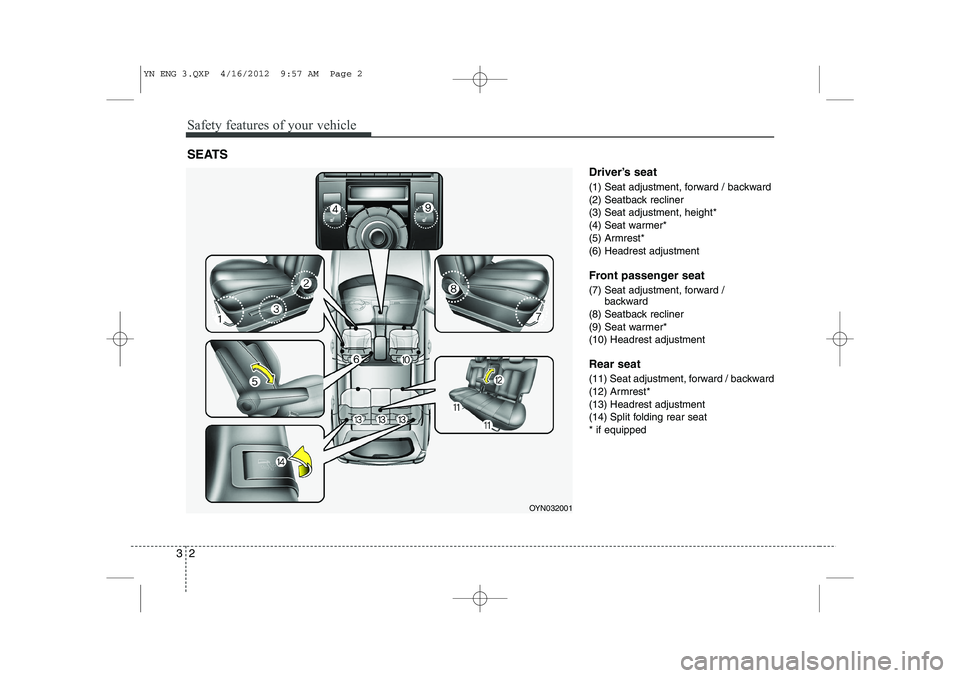
Safety features of your vehicle
2
3
Driver’s seat
(1) Seat adjustment, forward / backward
(2) Seatback recliner
(3) Seat adjustment, height*
(4) Seat warmer*
(5) Armrest*
(6) Headrest adjustment
Front passenger seat
(7) Seat adjustment, forward /
backward
(8) Seatback recliner
(9) Seat warmer*
(10) Headrest adjustment Rear seat
(11) Seat adjustment, forward / backward
(12) Armrest*
(13) Headrest adjustment
(14) Split folding rear seat* if equipped
SEATS
OYN032001
YN ENG 3.QXP 4/16/2012 9:57 AM Page 2
Page 17 of 751
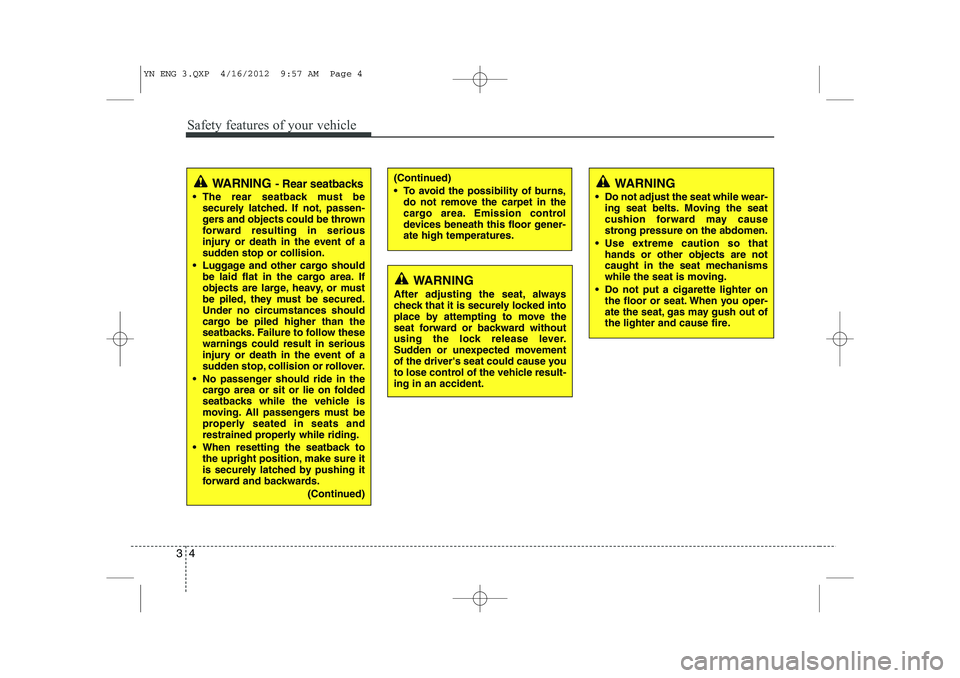
Safety features of your vehicle
4
3
(Continued)
To avoid the possibility of burns,
do not remove the carpet in the
cargo area. Emission control
devices beneath this floor gener-ate high temperatures.WARNING - Rear seatbacks
The rear seatback must be securely latched. If not, passen-
gers and objects could be thrown
forward resulting in serious
injury or death in the event of a
sudden stop or collision.
Luggage and other cargo should be laid flat in the cargo area. If
objects are large, heavy, or must
be piled, they must be secured.
Under no circumstances should
cargo be piled higher than the
seatbacks. Failure to follow thesewarnings could result in serious
injury or death in the event of a
sudden stop, collision or rollover.
No passenger should ride in the cargo area or sit or lie on folded
seatbacks while the vehicle is
moving. All passengers must be
properly seated in seats and
restrained properly while riding.
When resetting the seatback to the upright position, make sure it
is securely latched by pushing it
forward and backwards.
(Continued)
WARNING
After adjusting the seat, always
check that it is securely locked into
place by attempting to move the
seat forward or backward without
using the lock release lever.
Sudden or unexpected movement
of the driver's seat could cause you
to lose control of the vehicle result-ing in an accident.
WARNING
Do not adjust the seat while wear- ing seat belts. Moving the seat
cushion forward may cause
strong pressure on the abdomen.
Use extreme caution so that hands or other objects are not
caught in the seat mechanisms
while the seat is moving.
Do not put a cigarette lighter on the floor or seat. When you oper-
ate the seat, gas may gush out of
the lighter and cause fire.
YN ENG 3.QXP 4/16/2012 9:57 AM Page 4
Page 23 of 751
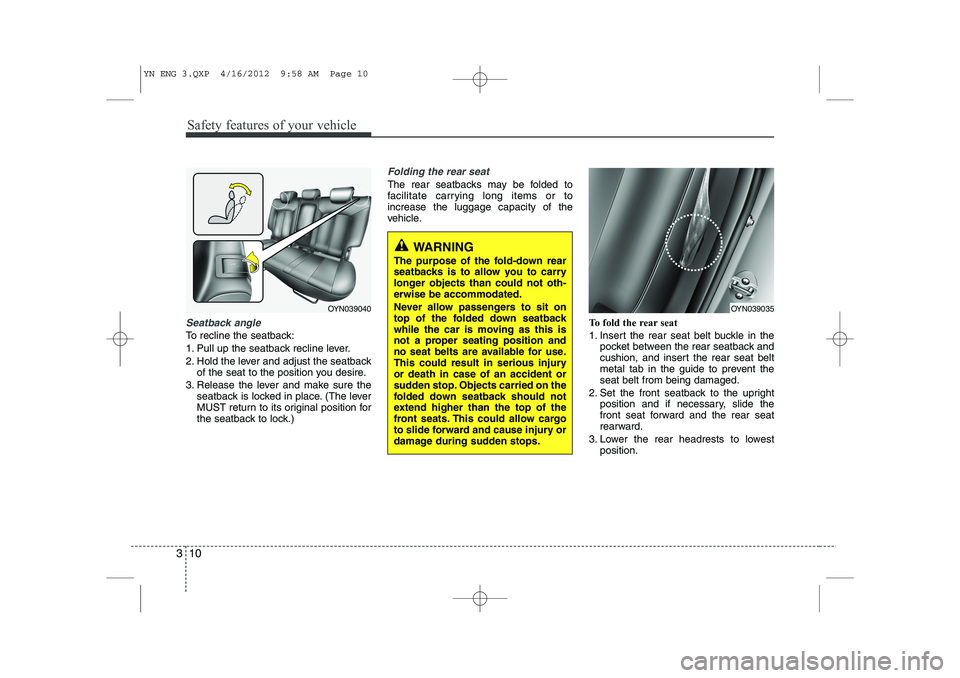
Safety features of your vehicle
10
3
Seatback angle
To recline the seatback:
1. Pull up the seatback recline lever.
2. Hold the lever and adjust the seatback
of the seat to the position you desire.
3. Release the lever and make sure the seatback is locked in place. (The lever
MUST return to its original position for
the seatback to lock.)
Folding the rear seat
The rear seatbacks may be folded to
facilitate carrying long items or toincrease the luggage capacity of the
vehicle.
To fold the rear seat
1. Insert the rear seat belt buckle in thepocket between the rear seatback and
cushion, and insert the rear seat belt
metal tab in the guide to prevent theseat belt from being damaged.
2. Set the front seatback to the upright position and if necessary, slide the
front seat forward and the rear seat
rearward.
3. Lower the rear headrests to lowest position.
WARNING
The purpose of the fold-down rear
seatbacks is to allow you to carry
longer objects than could not oth-erwise be accommodated.
Never allow passengers to sit on
top of the folded down seatback
while the car is moving as this is
not a proper seating position and
no seat belts are available for use.
This could result in serious injuryor death in case of an accident or
sudden stop. Objects carried on the
folded down seatback should not
extend higher than the top of the
front seats. This could allow cargo
to slide forward and cause injury or
damage during sudden stops.
OYN039035OYN039040
YN ENG 3.QXP 4/16/2012 9:58 AM Page 10
Page 24 of 751
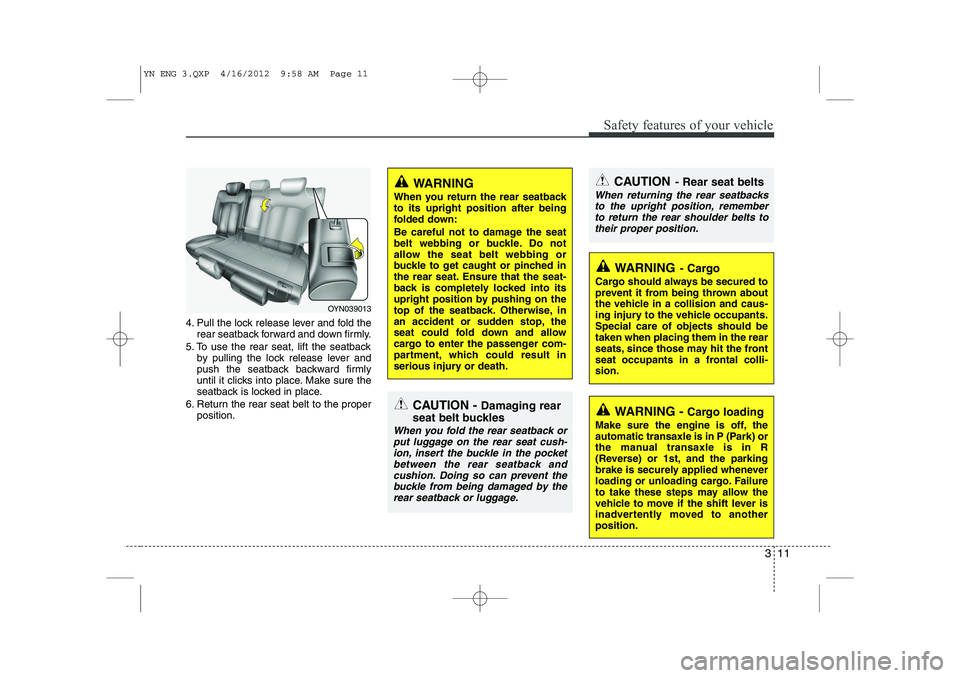
311
Safety features of your vehicle
4. Pull the lock release lever and fold therear seatback forward and down firmly.
5. To use the rear seat, lift the seatback by pulling the lock release lever and
push the seatback backward firmly
until it clicks into place. Make sure the
seatback is locked in place.
6. Return the rear seat belt to the proper position.
WARNING
When you return the rear seatback to its upright position after being
folded down:
Be careful not to damage the seat
belt webbing or buckle. Do not
allow the seat belt webbing or
buckle to get caught or pinched in
the rear seat. Ensure that the seat-
back is completely locked into its
upright position by pushing on the
top of the seatback. Otherwise, in
an accident or sudden stop, the
seat could fold down and allow
cargo to enter the passenger com-
partment, which could result in
serious injury or death.
CAUTION - Damaging rear
seat belt buckles
When you fold the rear seatback or put luggage on the rear seat cush-ion, insert the buckle in the pocket
between the rear seatback andcushion. Doing so can prevent the buckle from being damaged by therear seatback or luggage.
OYN039013
WARNING - Cargo loading
Make sure the engine is off, the
automatic transaxle is in P (Park) or
the manual transaxle is in R
(Reverse) or 1st, and the parking
brake is securely applied whenever
loading or unloading cargo. Failure
to take these steps may allow the
vehicle to move if the shift lever is
inadvertently moved to anotherposition.
WARNING - Cargo
Cargo should always be secured to
prevent it from being thrown about
the vehicle in a collision and caus-
ing injury to the vehicle occupants.Special care of objects should betaken when placing them in the rear
seats, since those may hit the front
seat occupants in a frontal colli-sion.
CAUTION - Rear seat belts
When returning the rear seatbacks
to the upright position, remember
to return the rear shoulder belts to their proper position.
YN ENG 3.QXP 4/16/2012 9:58 AM Page 11
Page 38 of 751
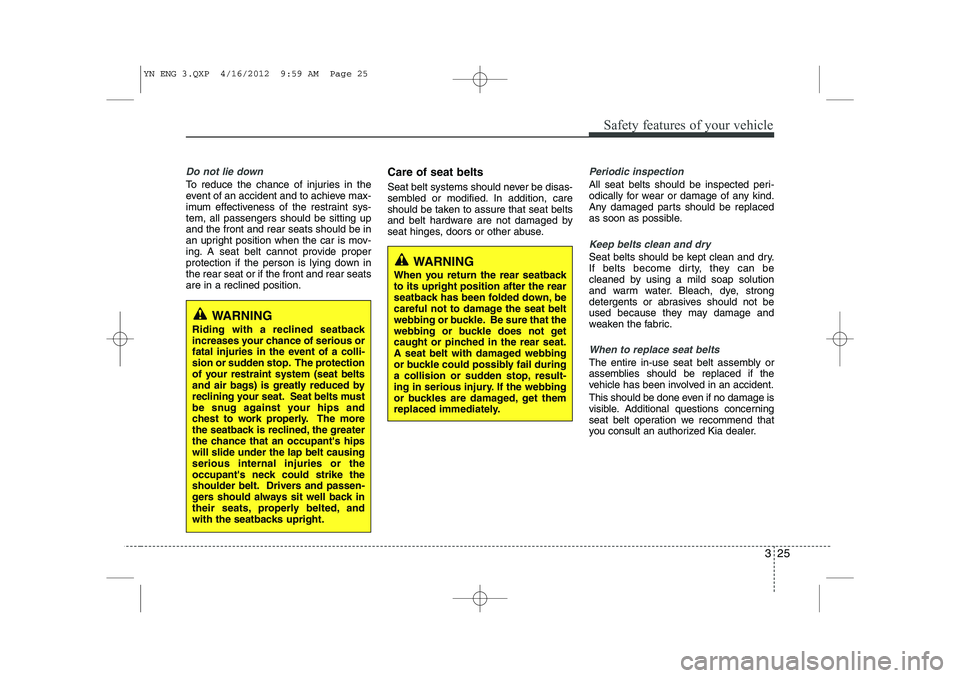
325
Safety features of your vehicle
Do not lie down
To reduce the chance of injuries in the
event of an accident and to achieve max-
imum effectiveness of the restraint sys-tem, all passengers should be sitting upand the front and rear seats should be in
an upright position when the car is mov-
ing. A seat belt cannot provide proper
protection if the person is lying down inthe rear seat or if the front and rear seatsare in a reclined position.Care of seat belts
Seat belt systems should never be disas-
sembled or modified. In addition, care
should be taken to assure that seat belts
and belt hardware are not damaged by
seat hinges, doors or other abuse.
Periodic inspection
All seat belts should be inspected peri-
odically for wear or damage of any kind.
Any damaged parts should be replaced
as soon as possible.
Keep belts clean and dry
Seat belts should be kept clean and dry.
If belts become dirty, they can be
cleaned by using a mild soap solution
and warm water. Bleach, dye, strong
detergents or abrasives should not be
used because they may damage and
weaken the fabric.
When to replace seat belts
The entire in-use seat belt assembly or
assemblies should be replaced if the
vehicle has been involved in an accident.
This should be done even if no damage is
visible. Additional questions concerning
seat belt operation we recommend that
you consult an authorized Kia dealer.
WARNING
When you return the rear seatback to its upright position after the rear
seatback has been folded down, be
careful not to damage the seat belt
webbing or buckle. Be sure that the
webbing or buckle does not get
caught or pinched in the rear seat.
A seat belt with damaged webbing
or buckle could possibly fail during
a collision or sudden stop, result-
ing in serious injury. If the webbing
or buckles are damaged, get them
replaced immediately.
WARNING
Riding with a reclined seatback
increases your chance of serious or
fatal injuries in the event of a colli-
sion or sudden stop. The protection
of your restraint system (seat belts
and air bags) is greatly reduced by
reclining your seat. Seat belts must
be snug against your hips and
chest to work properly. The more
the seatback is reclined, the greater
the chance that an occupant's hipswill slide under the lap belt causingserious internal injuries or the
occupant's neck could strike the
shoulder belt. Drivers and passen-
gers should always sit well back in
their seats, properly belted, andwith the seat backs upright.
YN ENG 3.QXP 4/16/2012 9:59 AM Page 25
Page 71 of 751
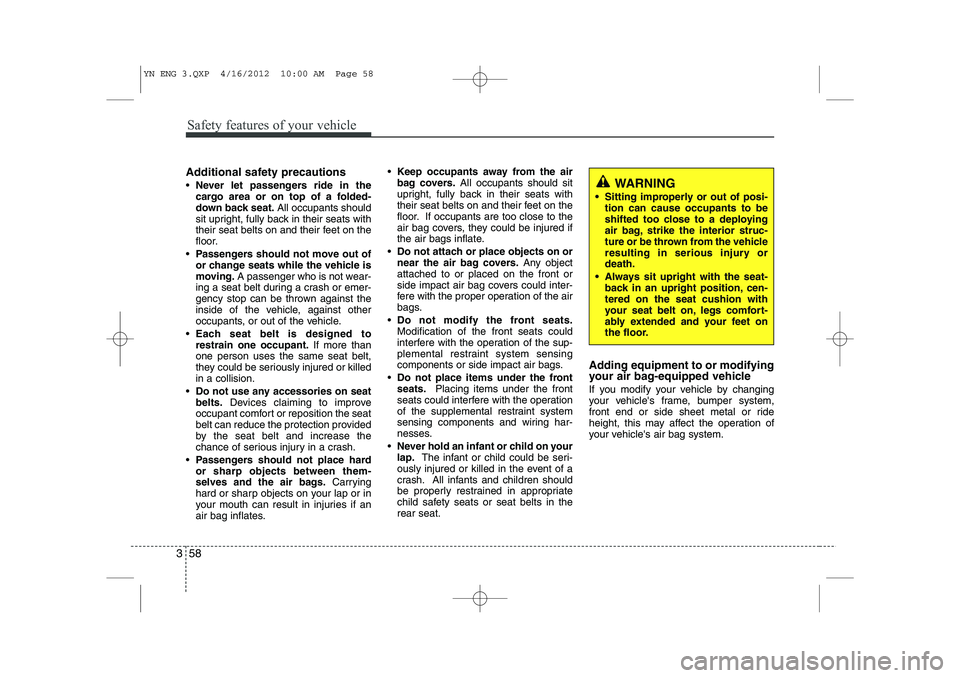
Safety features of your vehicle
58
3
Additional safety precautions Never let passengers ride in the
cargo area or on top of a folded-
down back seat. All occupants should
sit upright, fully back in their seats with
their seat belts on and their feet on the
floor.
Passengers should not move out of
or change seats while the vehicle is
moving. A passenger who is not wear-
ing a seat belt during a crash or emer-
gency stop can be thrown against the
inside of the vehicle, against other
occupants, or out of the vehicle.
Each seat belt is designed torestrain one occupant. If more than
one person uses the same seat belt,
they could be seriously injured or killedin a collision.
Do not use any accessories on seatbelts. Devices claiming to improve
occupant comfort or reposition the seat
belt can reduce the protection provided
by the seat belt and increase the
chance of serious injury in a crash.
Passengers should not place hardor sharp objects between them-
selves and the air bags. Carrying
hard or sharp objects on your lap or in
your mouth can result in injuries if an
air bag inflates.
Keep occupants away from the air
bag covers. All occupants should sit
upright, fully back in their seats with
their seat belts on and their feet on the
floor. If occupants are too close to the
air bag covers, they could be injured if
the air bags inflate.
Do not attach or place objects on or
near the air bag covers. Any object
attached to or placed on the front or
side impact air bag covers could inter-
fere with the proper operation of the air
bags.
Do not modify the front seats.Modification of the front seats could
interfere with the operation of the sup-
plemental restraint system sensing
components or side impact air bags.
Do not place items under the frontseats. Placing items under the front
seats could interfere with the operation
of the supplemental restraint system
sensing components and wiring har-
nesses.
Never hold an infant or child on yourlap. The infant or child could be seri-
ously injured or killed in the event of a
crash. All infants and children should
be properly restrained in appropriate
child safety seats or seat belts in therear seat. Adding equipment to or modifying
your air bag-equipped vehicle
If you modify your vehicle by changing
your vehicle's frame, bumper system,
front end or side sheet metal or ride
height, this may affect the operation of
your vehicle's air bag system.
WARNING
Sitting improperly or out of posi- tion can cause occupants to be
shifted too close to a deploying
air bag, strike the interior struc-
ture or be thrown from the vehicle
resulting in serious injury ordeath.
Always sit upright with the seat- back in an upright position, cen-tered on the seat cushion with
your seat belt on, legs comfort-
ably extended and your feet on
the floor.
YN ENG 3.QXP 4/16/2012 10:00 AM Page 58
Page 391 of 751
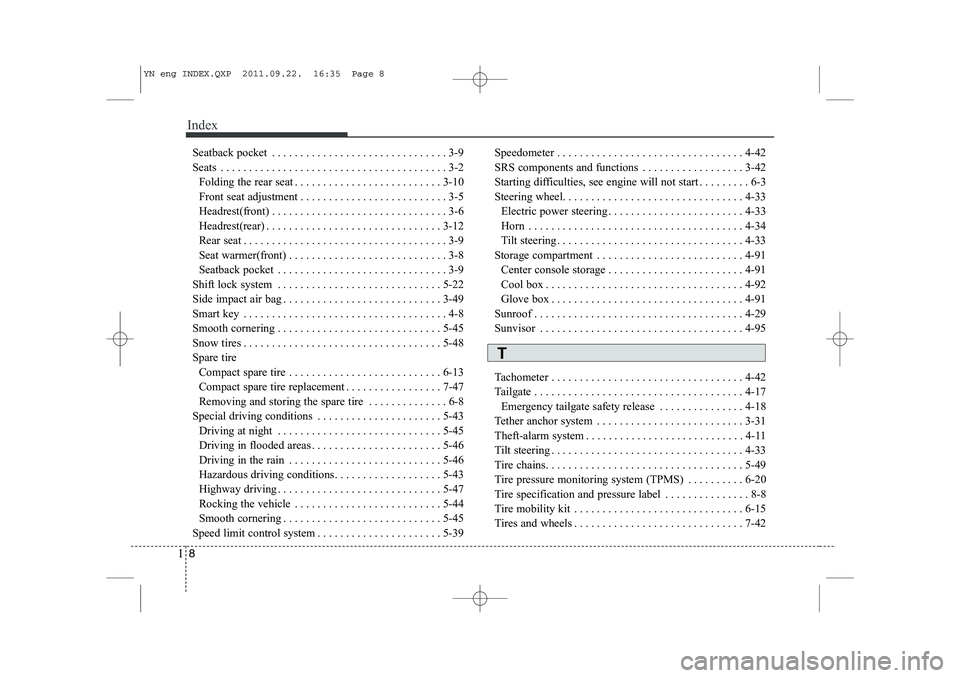
Index
8
I
Seatback pocket . . . . . . . . . . . . . . . . . . . . . . . . . . . . . . . 3-9
Seats . . . . . . . . . . . . . . . . . . . . . . . . . . . . . . . . . . . . . . . . 3-2
Folding the rear seat . . . . . . . . . . . . . . . . . . . . . . . . . . 3-10
Front seat adjustment . . . . . . . . . . . . . . . . . . . . . . . . . . 3-5
Headrest(front) . . . . . . . . . . . . . . . . . . . . . . . . . . . . . . . 3-6
Headrest(rear) . . . . . . . . . . . . . . . . . . . . . . . . . . . . . . . 3-12
Rear seat . . . . . . . . . . . . . . . . . . . . . . . . . . . . . . . . . . . . 3-9
Seat warmer(front) . . . . . . . . . . . . . . . . . . . . . . . . . . . . 3-8
Seatback pocket . . . . . . . . . . . . . . . . . . . . . . . . . . . . . . 3-9
Shift lock system . . . . . . . . . . . . . . . . . . . . . . . . . . . . . 5-22
Side impact air bag . . . . . . . . . . . . . . . . . . . . . . . . . . . . 3-49
Smart key . . . . . . . . . . . . . . . . . . . . . . . . . . . . . . . . . . . . 4-8
Smooth cornering . . . . . . . . . . . . . . . . . . . . . . . . . . . . . 5-45
Snow tires . . . . . . . . . . . . . . . . . . . . . . . . . . . . . . . . . . . 5-48Spare tire Compact spare tire . . . . . . . . . . . . . . . . . . . . . . . . . . . 6-13
Compact spare tire replacement . . . . . . . . . . . . . . . . . 7-47
Removing and storing the spare tire . . . . . . . . . . . . . . 6-8
Special driving conditions . . . . . . . . . . . . . . . . . . . . . . 5-43
Driving at night . . . . . . . . . . . . . . . . . . . . . . . . . . . . . 5-45
Driving in flooded areas . . . . . . . . . . . . . . . . . . . . . . . 5-46
Driving in the rain . . . . . . . . . . . . . . . . . . . . . . . . . . . 5-46
Hazardous driving conditions. . . . . . . . . . . . . . . . . . . 5-43
Highway driving . . . . . . . . . . . . . . . . . . . . . . . . . . . . . 5-47
Rocking the vehicle . . . . . . . . . . . . . . . . . . . . . . . . . . 5-44
Smooth cornering . . . . . . . . . . . . . . . . . . . . . . . . . . . . 5-45
Speed limit control system . . . . . . . . . . . . . . . . . . . . . . 5-39 Speedometer . . . . . . . . . . . . . . . . . . . . . . . . . . . . . . . . . 4-42
SRS components and functions . . . . . . . . . . . . . . . . . . 3-42
Starting difficulties, see engine will not start . . . . . . . . . 6-3
Steering wheel. . . . . . . . . . . . . . . . . . . . . . . . . . . . . . . . 4-33
Electric power steering . . . . . . . . . . . . . . . . . . . . . . . . 4-33
Horn . . . . . . . . . . . . . . . . . . . . . . . . . . . . . . . . . . . . . . 4-34
Tilt steering . . . . . . . . . . . . . . . . . . . . . . . . . . . . . . . . . 4-33
Storage compartment . . . . . . . . . . . . . . . . . . . . . . . . . . 4-91
Center console storage . . . . . . . . . . . . . . . . . . . . . . . . 4-91
Cool box . . . . . . . . . . . . . . . . . . . . . . . . . . . . . . . . . . . 4-92
Glove box . . . . . . . . . . . . . . . . . . . . . . . . . . . . . . . . . . 4-91
Sunroof . . . . . . . . . . . . . . . . . . . . . . . . . . . . . . . . . . . . . 4-29
Sunvisor . . . . . . . . . . . . . . . . . . . . . . . . . . . . . . . . . . . . 4-95
Tachometer . . . . . . . . . . . . . . . . . . . . . . . . . . . . . . . . . . 4-42
Tailgate . . . . . . . . . . . . . . . . . . . . . . . . . . . . . . . . . . . . . 4-17 Emergency tailgate safety release . . . . . . . . . . . . . . . 4-18
Tether anchor system . . . . . . . . . . . . . . . . . . . . . . . . . . 3-31
Theft-alarm system . . . . . . . . . . . . . . . . . . . . . . . . . . . . 4-11
Tilt steering . . . . . . . . . . . . . . . . . . . . . . . . . . . . . . . . . . 4-33
Tire chains. . . . . . . . . . . . . . . . . . . . . . . . . . . . . . . . . . . 5-49
Tire pressure monitoring system (TPMS) . . . . . . . . . . 6-20
Tire specification and pressure label . . . . . . . . . . . . . . . 8-8
Tire mobility kit . . . . . . . . . . . . . . . . . . . . . . . . . . . . . . 6-15
Tires and wheels . . . . . . . . . . . . . . . . . . . . . . . . . . . . . . 7-42
T
YN eng INDEX.QXP 2011.09.22. 16:35 Page 8
Page 407 of 751
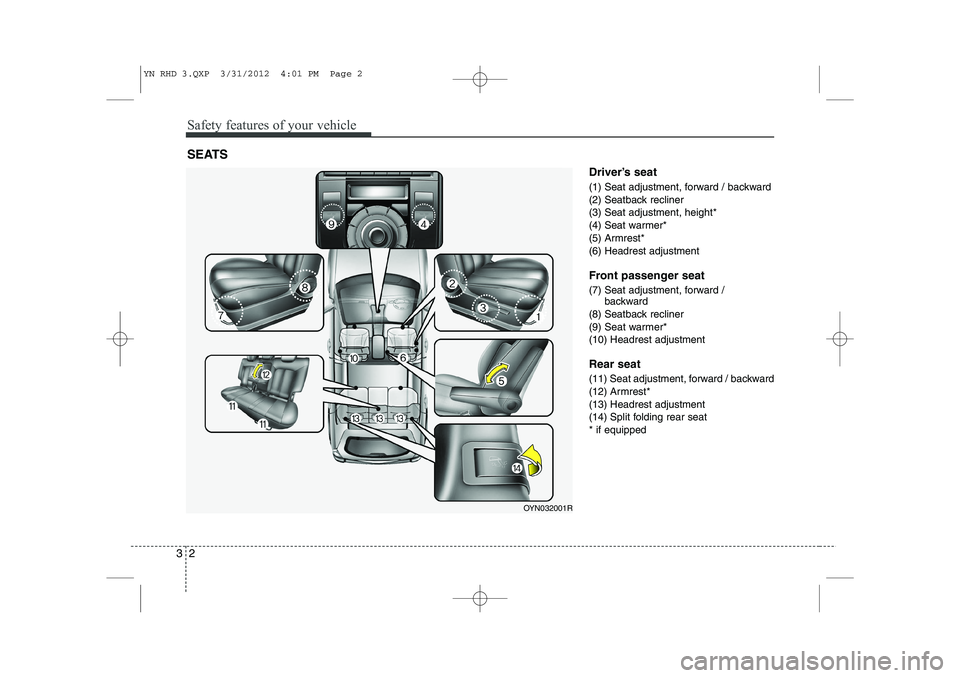
Safety features of your vehicle
2
3
Driver’s seat
(1) Seat adjustment, forward / backward
(2) Seatback recliner
(3) Seat adjustment, height*
(4) Seat warmer*
(5) Armrest*
(6) Headrest adjustment
Front passenger seat
(7) Seat adjustment, forward /
backward
(8) Seatback recliner
(9) Seat warmer*
(10) Headrest adjustment Rear seat
(11) Seat adjustment, forward / backward
(12) Armrest*
(13) Headrest adjustment
(14) Split folding rear seat* if equipped
SEATS
OYN032001R
YN RHD 3.QXP 3/31/2012 4:01 PM Page 2